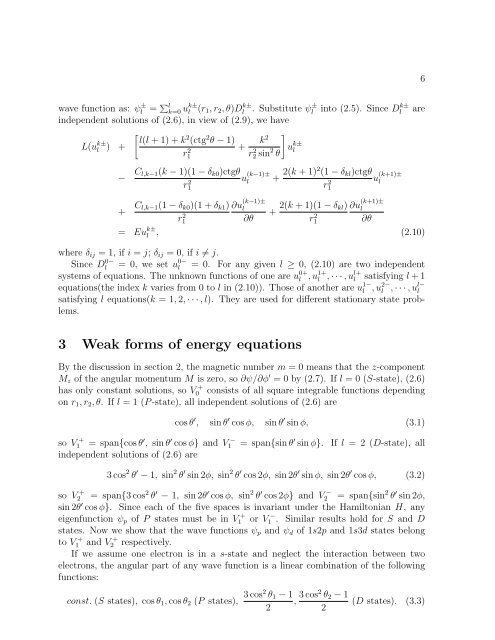Finite element calculations for the helium atom∗ 1 Introduction
Finite element calculations for the helium atom∗ 1 Introduction
Finite element calculations for the helium atom∗ 1 Introduction
Create successful ePaper yourself
Turn your PDF publications into a flip-book with our unique Google optimized e-Paper software.
wave function as: ψ ± l = �l k=0 u k±<br />
l (r1, r2, θ)D k±<br />
l . Substitute ψ ± l into (2.5). Since D k±<br />
l<br />
independent solutions of (2.6), in view of (2.9), we have<br />
L(u k±<br />
l ) +<br />
� l(l + 1) + k 2 (ctg 2 θ − 1)<br />
r 2 1<br />
+ k2<br />
r2 2 sin 2 �<br />
u<br />
θ<br />
k±<br />
l<br />
− Cl,k−1(k − 1)(1 − δk0)ctgθ<br />
r2 u<br />
1<br />
(k−1)±<br />
l<br />
+ Cl,k−1(1 − δk0)(1 + δk1)<br />
r 2 1<br />
∂u (k−1)±<br />
l<br />
∂θ<br />
+ 2(k + 1)2 (1 − δkl)ctgθ<br />
r2 u<br />
1<br />
(k+1)±<br />
l<br />
+ 2(k + 1)(1 − δkl)<br />
r 2 1<br />
∂u (k+1)±<br />
l<br />
∂θ<br />
= Eu k±<br />
l , (2.10)<br />
where δij = 1, if i = j; δij = 0, if i �= j.<br />
Since D 0−<br />
l = 0, we set u0− l = 0. For any given l ≥ 0, (2.10) are two independent<br />
systems of equations. The unknown functions of one are u 0+<br />
l , u 1+<br />
l , · · · , u l+<br />
l satisfying l + 1<br />
equations(<strong>the</strong> index k varies from 0 to l in (2.10)). Those of ano<strong>the</strong>r are u 1−<br />
l , u 2−<br />
l , · · · , u l−<br />
l<br />
satisfying l equations(k = 1, 2, · · · , l). They are used <strong>for</strong> different stationary state problems.<br />
3 Weak <strong>for</strong>ms of energy equations<br />
By <strong>the</strong> discussion in section 2, <strong>the</strong> magnetic number m = 0 means that <strong>the</strong> z-component<br />
Mz of <strong>the</strong> angular momentum M is zero, so ∂ψ/∂φ ′ = 0 by (2.7). If l = 0 (S-state), (2.6)<br />
has only constant solutions, so V +<br />
0 consists of all square integrable functions depending<br />
on r1, r2, θ. If l = 1 (P -state), all independent solutions of (2.6) are<br />
6<br />
are<br />
cos θ ′ , sin θ ′ cos φ, sin θ ′ sin φ, (3.1)<br />
so V +<br />
1 = span{cos θ ′ , sin θ ′ cos φ} and V −<br />
1 = span{sin θ ′ sin φ}. If l = 2 (D-state), all<br />
independent solutions of (2.6) are<br />
so V +<br />
2<br />
3 cos 2 θ ′ − 1, sin 2 θ ′ sin 2φ, sin 2 θ ′ cos 2φ, sin 2θ ′ sin φ, sin 2θ ′ cos φ, (3.2)<br />
= span{sin2 θ ′ sin 2φ,<br />
sin 2θ ′ cos φ}. Since each of <strong>the</strong> five spaces is invariant under <strong>the</strong> Hamiltonian H, any<br />
eigenfunction ψp of P states must be in V +<br />
1 or V −<br />
1 . Similar results hold <strong>for</strong> S and D<br />
= span{3 cos 2 θ ′ − 1, sin 2θ ′ cos φ, sin 2 θ ′ cos 2φ} and V −<br />
2<br />
states. Now we show that <strong>the</strong> wave functions ψp and ψd of 1s2p and 1s3d states belong<br />
to V +<br />
1 and V +<br />
2 respectively.<br />
If we assume one electron is in a s-state and neglect <strong>the</strong> interaction between two<br />
electrons, <strong>the</strong> angular part of any wave function is a linear combination of <strong>the</strong> following<br />
functions:<br />
const. (S states), cos θ1, cos θ2 (P states), 3 cos2 θ1 − 1<br />
,<br />
2<br />
3 cos2 θ2 − 1<br />
2<br />
(D states). (3.3)


